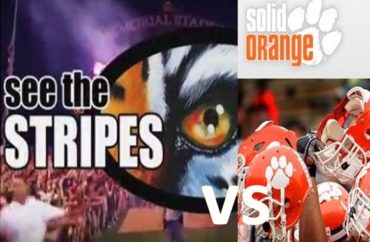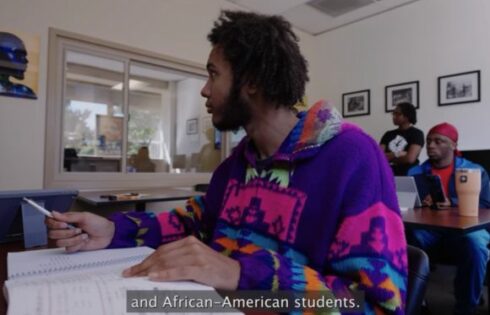
Clemson University’s mascot, the tiger, has long been a symbol of strength and unity among the campus community. We wear orange as a unifying emblem that brings us all together and connects us regardless of our differences. We don’t see black, white, rich, poor, gay, straight — all that is erased by orange pride. Through this, we let go of division and come together as one.
Yet this year Clemson University decided in some ways to abandon the “solid orange” rhetoric that has long unified this campus and replace it with a new suggestion: “see the stripes.” The stripes of the tiger, that is.
This semester’s annual First Friday parade used to serve as a way for the Clemson community to come together in celebration of the start of a new school year and the excitement for a successful football season, proud that we are currently ranked among the top three college football teams in the nation.
However, the theme of this year’s parade — “The Stripes That Make a Tiger” — missed its mark at unifying the campus community. To be sure, the notions behind it sounded good: “Just as a tiger is not complete without its stripes, the Clemson family is not complete without the diverse experiences and contributions of students and alumni.”
But I felt the theme divided and separated the campus community rather than brought us together as intended. Clemson’s parade should not have randomly celebrated diversity on campus at an event that, until this year, has solely dedicated itself to celebrating Clemson’s clubs, programs, and football season, since 1974.
The inspiration, and some say plagiarism, for the See the Stripes campaign came from A.D. Carson, a PhD recipient in rhetorics, communication, and information design at Clemson University, who recently became the University of Virginia’s first assistant professor of hip-hop.
Carson, in his 2016 “See the Stripes” artistic piece, encouraged the Clemson community to reject its “solid orange” mantra — an ode to its tiger mascot — and instead see the full tiger, stripes and all.
“As the stripes on The Tiger complete the picture of the university’s mascot, acknowledging the stripes on the uniforms of convict laborers, the strips of land worked by the sharecroppers, and the slaves, who bore stripes on their backs, help provide a necessary, more complete view of the history of Clemson University,” Carson stated.
It directly retaliated against Clemson’s “Solid Orange campaign,” which aims to connect the Clemson community using the traditional color its mascot and athlete-scholars wear. “Solid Orange goes far beyond orange T-shirts. It’s thinking and acting like a winner, knowing that everything we do reflects on every other Tiger,” a campus official explains.
The Clemson community doesn’t need to “see the stripes.” Do the stripes make the tiger or does the tiger make the stripes? Solid orange is a show of unity and pride among the entire Clemson community that encourages a campus-wide victor mentality.
But Carson suggests solid orange is “incomplete and inaccurate” since it does not acknowledge Clemson’s negative history of Black “slaves, sharecroppers, and convict laborers.” Carson refers to the black slaves that labored to till the grounds of Fort Hill, the estate of former South Carolina Senator and Vice President, John C. Calhoun, who was the father-in-law to Clemson’s founder, Thomas G. Clemson.
Carson equates the “dark parts” of Clemson’s history of enslavement to the black stripes that adorn a tiger, arguing that the school would not have survived without its use of slave labor, just as “a solid orange tiger could not survive without its stripes.”
Carson insinuates that students of color at Clemson and other universities have trouble even “surviving” on a campus that he claims (without evidence) faces challenges in upholding aspects of diversity and inclusion.
As a black student at Clemson, I unquestionably disagree with that assessment.
Just as a tiger instinctually acknowledges its own stripes, so too does Clemson acknowledge its diverse student population, who proudly don orange like a unified family. What both Carson and Clemson’s administration fail to see is that Clemson’s motto of “Solid Orange” sees no color other than the school’s trademark orange, existing as the defining symbol for the student body, including and not limited toward: Blacks, Whites, Hispanics, Asians, and all other races.
Clemson’s orange inherently includes its black stripes, not covering them up as Carson argues. A tiger does not think of its black stripes as separate from its orange fur, just as Clemson’s orange does not see Black students as separate from the community as a whole.
Clemson proudly acknowledges southern pride and has respectfully made amends to its checkered history of slavery through the school’s current mission of diversity and inclusion, accepting all students on a basis of merit, not race.
In contrast, Carson’s “See The Stripes” and Clemson’s “The Stripes That Make a Tiger” inadvertently invoke a mindset of division between whites and students of color, oblivious to the already prevalent presence of diversity at the school.
Both initiatives blindly assume that Clemson has failed to recognize its many administrators and students of color. But for nearly 50 years, the school has honored and upheld a profound respect for all races through admitting its first Black student, Harvey Gantt, who graduated from Clemson with honors in 1965.
“See The Stripes.” “The Stripes That Make a Tiger.”
Both titles should be changed to “See The Students That Make a Tiger.”
MORE: California university works to reduce number of white people on campus
Like The College Fix on Facebook / Follow us on Twitter





Please join the conversation about our stories on Facebook, Twitter, Instagram, Reddit, MeWe, Rumble, Gab, Minds and Gettr.